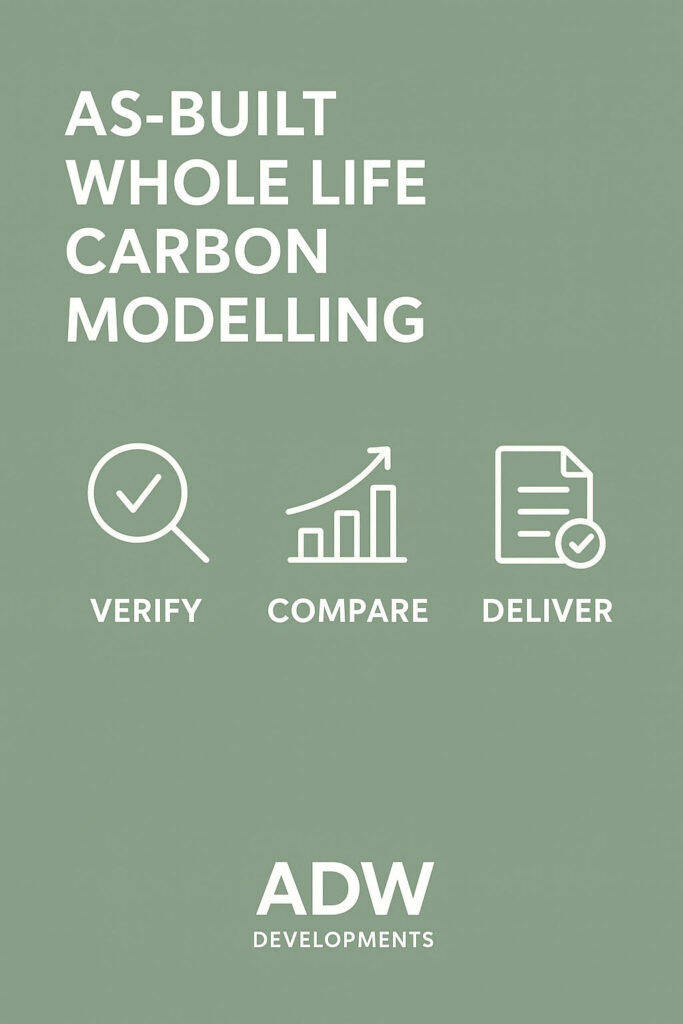Achieving Whole Life Carbon (WLC) compliance no longer stops at the design stage. Under BREEAM UK New Construction V7 and GLA London Plan guidance, the true challenge lies in demonstrating that your as-built scheme performs as predicted, and that the assumptions made during design have been realised in measurable carbon outcomes.
This is where Verifying As-Built Carbon plays a crucial role. So, we will have a closer look at it in today’s Knowledge Share.

Why As-Built Matters
Design-stage WLC assessments are based on forecasts, provisional specifications, and tender data. Once a project reaches completion, however, the as-built model becomes the definitive proof point, confirming how procurement decisions, value engineering, and material substitutions have influenced the embodied carbon outcome.
For BREEAM V7, submitting an as-built WLC model is now regarded as best practice and is essential for securing the Mat 01 credits reliant on accurate post-construction verification. Increasingly, it is also expected by:
- GLA planning officers, as part of the Whole Life Carbon Reporting template;
- ESG investors, who require verifiable performance data; and
- Clients, seeking tangible evidence that carbon reductions have been achieved, not merely modelled.
Our Approach
At ADW Developments, we do not simply re-run the original design model, we rebuild it from the ground up. Our team captures verified as-built quantities, procurement records, and manufacturer EPDs to produce a final carbon model that truly reflects the real project.
Our As-Built WLC process includes:
- Data Reconciliation – aligning assumptions made during design with actual procurement data and construction records.
- Material Verification – confirming EPDs and embodied carbon factors against certified datasets.
- Variant Tracking – quantifying the impact of substitutions, changes, and value engineering decisions.
- Final Reporting – delivering an auditable WLC report suitable for BREEAM Mat 01 submission and GLA post-completion evidence.
The Benefits of As-Built WLC Verification
- Accuracy: Ensures carbon performance is rooted in actual, verified data.
- Credibility: Provides assessors, planners, and investors with independently verified results.
- Learning Feedback: Adds valuable insights for future projects, informing better design and procurement decisions.
- Compliance: Supports dual alignment with BREEAM V7, GLA guidance, and the Net Zero Carbon Building Standard frameworks.
Closing The Performance Gap
In the realm of sustainability reporting, credibility is paramount. As-Built WLC modelling transforms projected targets into proven outcomes, effectively closing the gap between design intent and delivered performance.
Under BREEAM V7, the requirements for Life Cycle Assessment are now explicitly mandated at three key project stages: concept, technical design, and as-built (Reference: BREEAM V7 Launch Documentation, July 2025). The GLA explicitly mandates a post-construction assessment, with the assessment typically required three months after project completion, prior to handover (Section 3.14).
The GLA WLC Guidance also specifies minimum evidence requirements for post-construction assessments, including:
- Site energy (including fuel) use records;
- Contractor confirmation of as-built material quantities and specifications;
- Records of material delivery including transportation details;
- Waste transportation records, including quantities and transport modes.
In addition, the post-construction WLC assessment must update the figures submitted at planning (RIBA Stage 2/3), providing a comparison with the original estimates and an explanation for any variances (Section 3.16). Review of submissions will focus on completeness, technical robustness, the scale of emission reductions achieved, and the overall level of ambition (Section 3.18).
At ADW Developments, we are committed to delivering the independent expertise and verification necessary to ensure your embodied carbon evidence not only complies but also stands up to rigorous technical and regulatory assessment, closing the loop between design aspirations and real-world outcomes.
